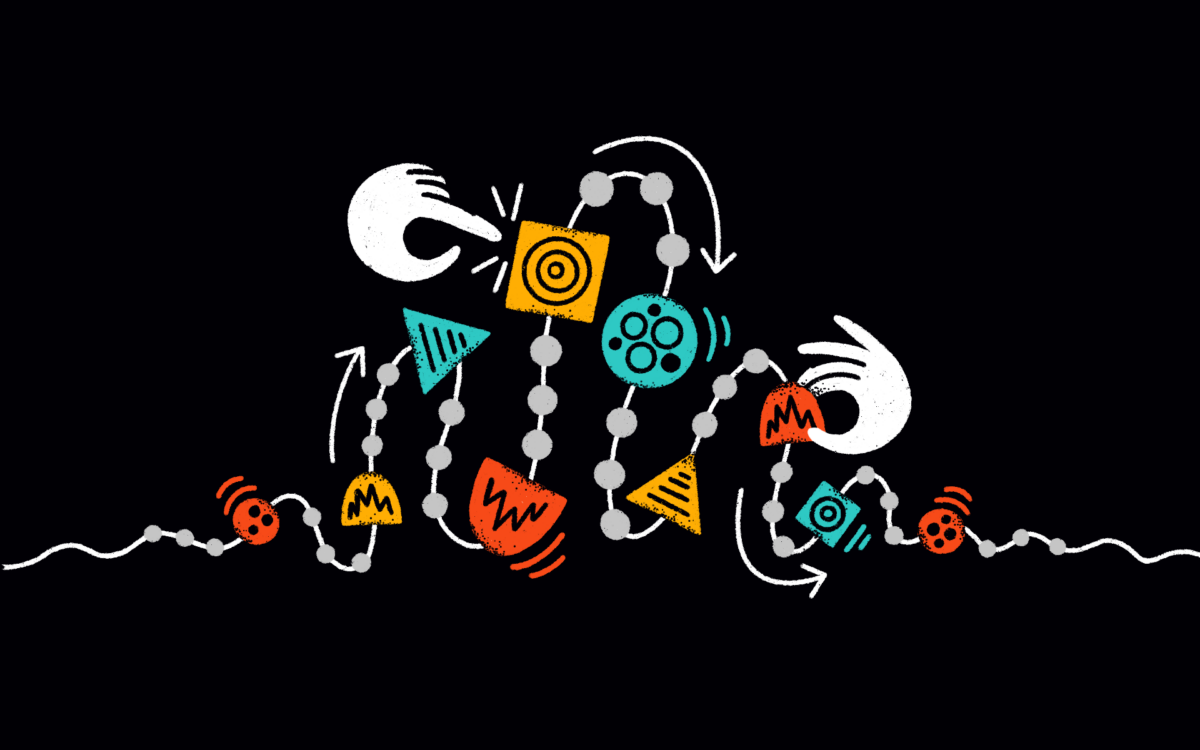Illustration: Laura Bee
What is rhythm in music?
We hear the word used all the time by music creators and listeners alike, but its exact definition and all of the elements it encompasses can be surprisingly ambiguous. So, whether you’re a beginner or a seasoned musician, it may be worth asking yourself: What is rhythm?
The short answer is, rhythm is perhaps the single most fundamental element of music.
Rhythm tells us the timing for where to place notes and rests in music. While entirely rhythm-driven music exists (ex. music created by hand claps), you can’t really have music that’s solely melodic—after all, how can we have a melody if we have no information about when its notes are going to strike? For this reason, it makes a lot of sense to define and learn about rhythm at the start of one’s musical journey.
To develop a crystal-clear understanding of the concept of rhythm, in this guide we explore its main elements one-by-one. See all of the topics via the table of contents below and feel free to use it to navigate to a specific section.
What you’ll learn:
- What is a beat in music?
- What is a meter in music?
- How to read a time signature
- What are rhythmic values?
- The sound of rhythms in action
- How to make your own rhythm
- What are dotted notes?
- What is tempo?
- Putting it all together
Feeling ready? Let’s dive into the world of rhythm, starting with a particularly fundamental element: the “beat.”
What is a beat in music?
Like the term “rhythm,” we casually use the word “beat” to refer to all sorts of things we hear. However, in the context of music theory, a beat is a passage of music’s steady, primary pulse. If you’ve ever tapped your foot or clapped along to a song, chances are you’ve done so in sync with the song’s beat.
If you’re not confident in your beat-keeping abilities, let’s use Avicii’s “Wake Me Up” as a simple exercise—try tapping your foot along to the song:
If you found your foot landing in sync with the thumping kick drum that entered at the chorus (0:39), congratulations—you successfully identified the beat!
You may also notice the clap sounds, which occur in between each of the kicks. Combined with the kick, these outline a pulse that’s twice as fast; this secondary pulse is referred to as the beat division.
What is a meter in music?
Now that we have a basic understanding of beats, let’s talk about how they’re organized. A meter in music helps us communicate how our beats are grouped and divided.
There are two primary types of meters in music: simple meters, which have beats that can be naturally divided into groups of two, and compound meters, which have beats that can be naturally divided into groups of three. Today, let’s focus on two common simple meter types that, together, cover a pretty large quantity of music.
1. Simple quadruple meter
If you try counting numbers aloud to the beat of “Wake Me Up,” you’ll find that repeating the phrase “one-two-three-four” makes the most sense—you might even find yourself naturally gravitating towards it. Furthermore, as we heard with the claps, the beats are divided into even groups of two (we can best include the claps in our counting by inserting an “and” in between each kick – e.g. “one-and-two-and-three-and-four-and“).
When the beats are organized in fours (one | two | three | four) and each beat can be divided into groups of two (one-and | two-and | three-and | four-and) in this way, we say that the specific meter type is simple quadruple.
2. Simple triple meter
While we’ll find ourselves counting to four for most popular music, there are also many songs that don’t fall under this umbrella. Take Billie Eilish’s “when the party’s over,” for example:
Notice how it feels more natural to count “one-two-three” with each phrase, as opposed to “one-two-three-four.” The division of each beat isn’t clear until Billie sings “Quiet when I’m coming home” (0:53), a phrase that delivers two evenly-spaced syllables per beat (you can easily replace the syllables in the line with “one-and-two-and-three-and-one”)—this confirms that the specific meter type is simple triple.
Simple triple meter can at times be confused with compound meters, because there can be a gray area where we’re unsure of whether we’re tapping along to a beat or its subdivision. In these instances, we make a determination based on which specific beats are emphasized by the music. If that went over your head, don’t worry; we’ll explore this idea in further detail another time.
What is rhythm in music: Applying your knowledge
Listen to the following songs, and determine whether they’re in simple quadruple or simple triple meter:
1. The Beatles’ “Here Comes The Sun”
2. Kelly Clarkson’s “Breakaway”
3. Bruno Mars’ “That’s What I Like”
How to read a time signature
Now that we have a basic understanding of simple meters, let’s figure out how to read a time signature that’s expressed in writing. Almost always, a piece of music will use a time signature that looks something like this:
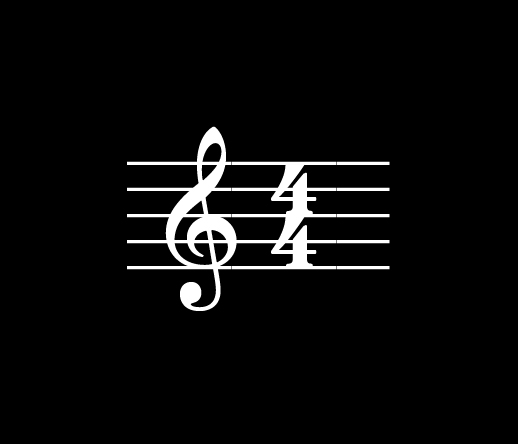
How a time signature appears in sheet music.

How a time signature appears in a DAW (Studio One).
Time signatures are expressed with two numbers that are presented like a fraction. With simple meters, each number conveys the following piece of information:
- The top value (the ‘numerator’) tells us whether the meter type is duple (2), triple (3), or quadruple (4). In other words, it tells us how many beats exist in each measure, a unit that helps us section our music into logical and digestible pieces (also known as a bar). We’ll explore measures / bars in further detail in a bit.
- The bottom value (the ‘denominator’) tells us if a beat is constituted by a half note (2), quarter note (4), eighth note (8), or sixteenth note (16).
Let’s walk through an example—in the above images, we see a time signature of 4/4. This means that our music is in quadruple meter (i.e. has four beats per measure), and that a quarter note is equivalent to one beat.
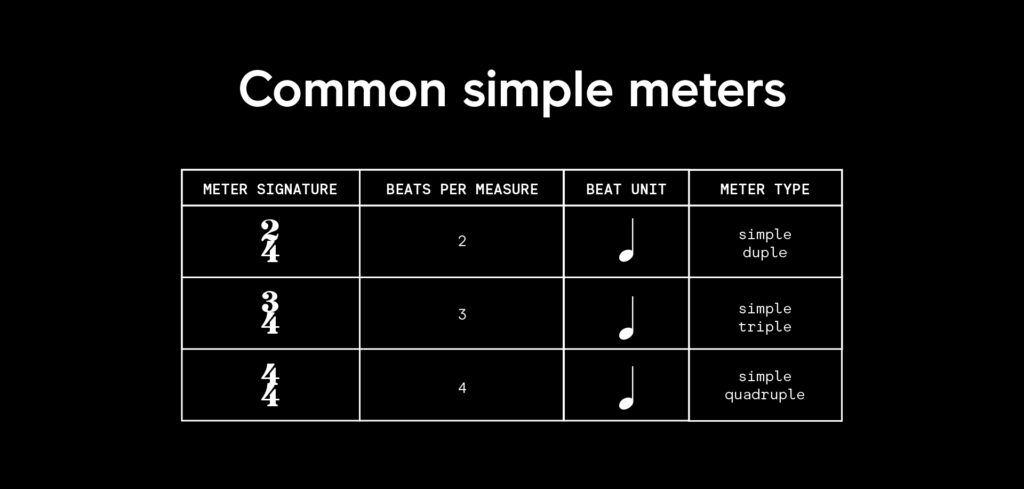
A chart of common time signatures and their meter types.
This raises the question: What’s a quarter note?
What are rhythmic values?
In order to create a rhythm that’s more than just a steady beat, we need to be able to have notes and rests (silences) that are of different durations. In sheet music, we use rhythmic values, which are unique symbols that tell us how long notes or rests last in relation to one another. See what they look like in the chart below.
Rhythmic values chart
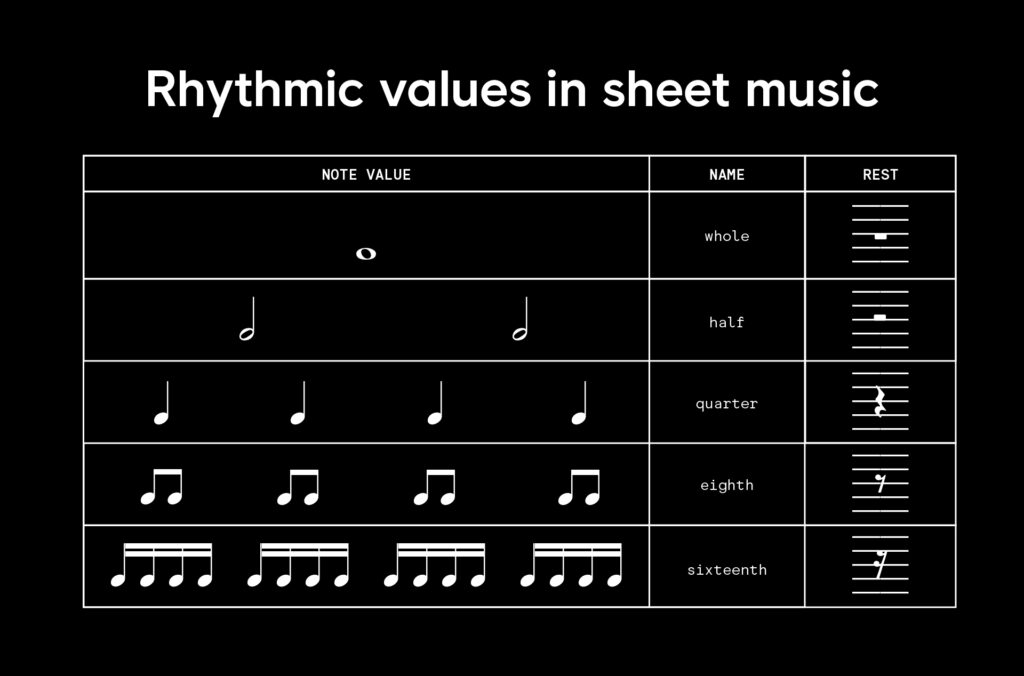
A chart listing common rhythmic values in sheet music, expressed as both notes and rests.
Note that one whole note, two half notes, four quarter notes, eight eighth notes, and sixteen sixteenth notes are all equivalent to one another in their total duration.
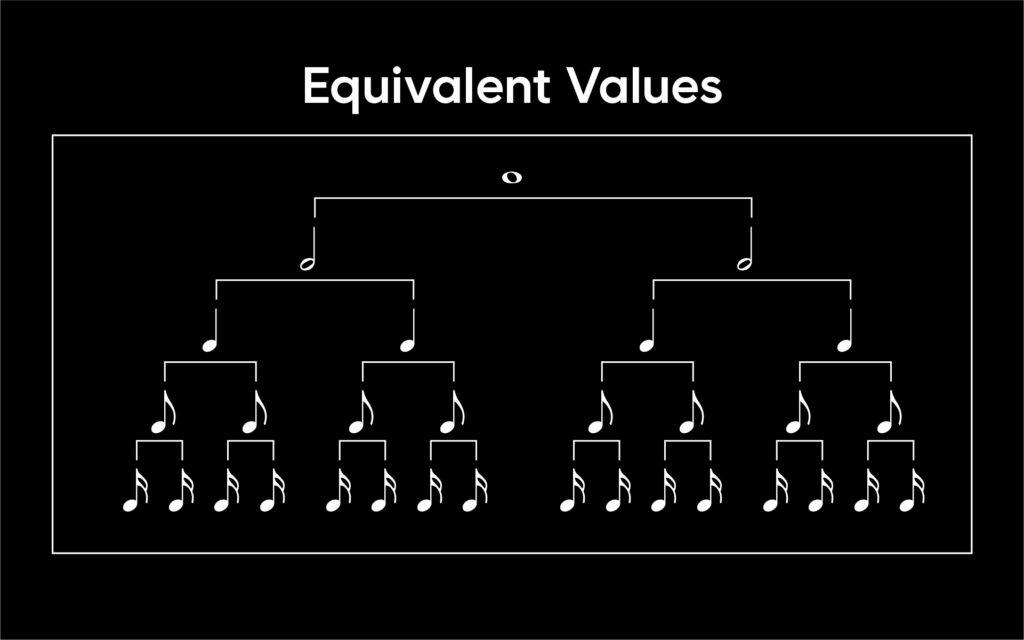
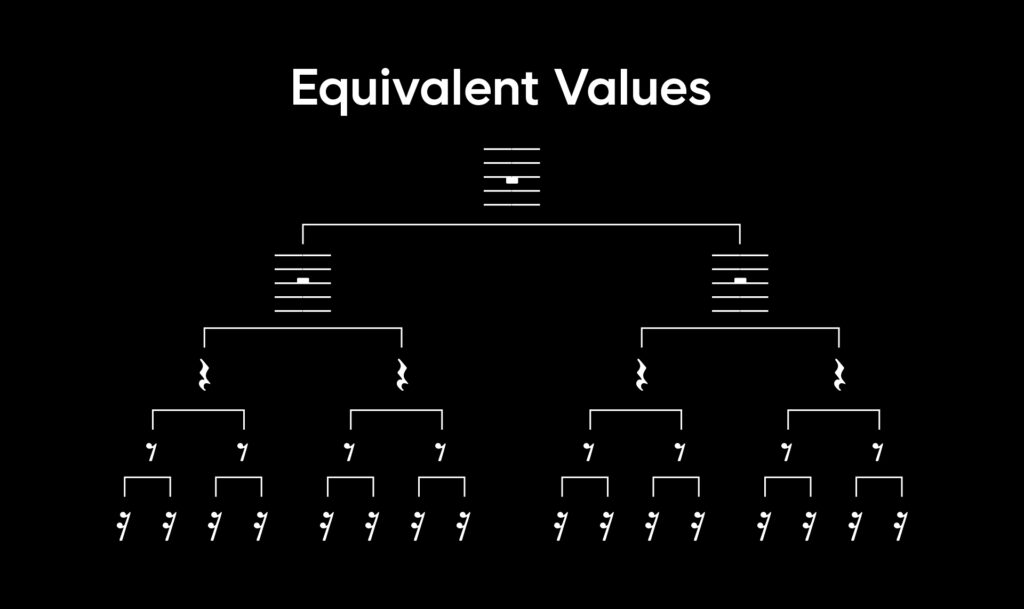
Rhythmic values in the DAW
When we’re working in a DAW (digital audio workstation), we’ll most likely be using a piano roll, where MIDI notes (pictured below) are sequenced across a grid. Here, different rhythmic values won’t have different symbols; rather, we’ll be looking at the length of the MIDI note in relation to the grid to determine its rhythmic value.
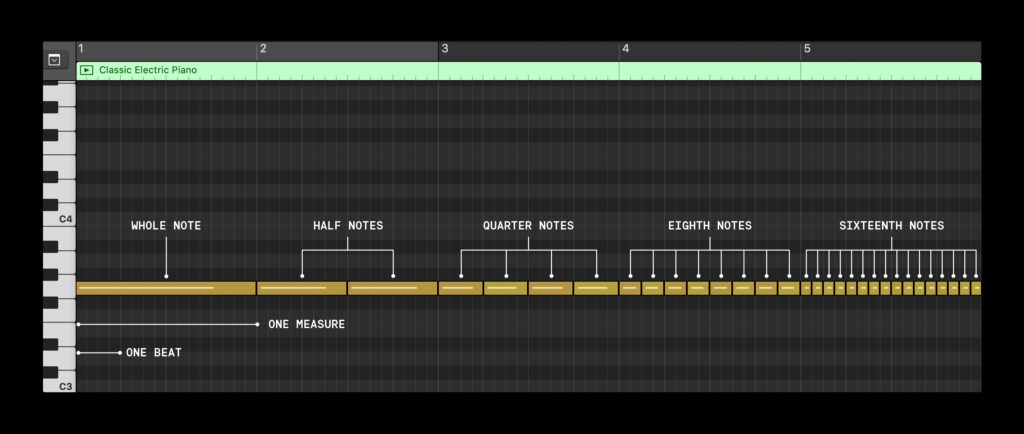
Consequently, any blank space where a note doesn’t exist is considered a rest.
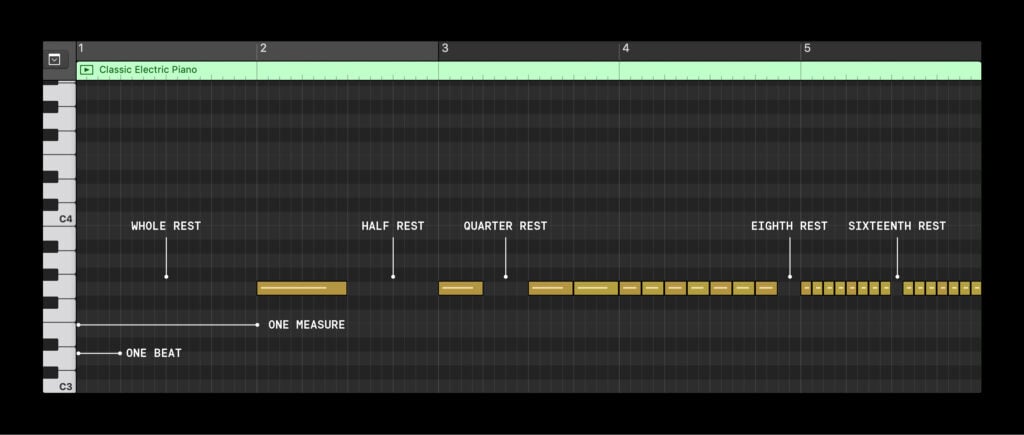
The sound of rhythms in action
Enough talk—now that we’ve learned about some different note values, let’s hear how they sound in action. The same musical excerpt is displayed in both sheet music and on a piano roll below:
Sheet music
The vertical lines, known as bar lines, denote where one measure ends and the next one begins. Measures are typically numbered so that we can easily reference specific moments in the music.
MIDI (piano roll)
Piano rolls not only have bar lines, but many other vertical lines that give us insight into the specific beat number and subdivisions.
In the example above, the metronome (the consistent clicking sound) is striking on each beat. If we follow it, we can hear that the whole note (measure one), four quarter notes (measure two), eight eighth notes (measure three), and sixteen quarter notes (measure four) all last for the same duration: one measure, or four beats.
How to make your own rhythm
Now that we’re familiar with some common rhythmic values, we can arrange and combine them to create some more interesting rhythms—hear an example below:
Sheet music
MIDI (piano roll)
Notice how all of the notes in each measure still add up to four beats; the first measure contains a half note (two beats) followed by two quarter notes (one beat each), the second measure contains an alternation between two quarter notes (one beat each) and two pairs of eighth notes (one beat each), etc.
What are dotted notes?
While you can do a lot with the rhythms we’ve covered so far, you may have noticed that they’re somewhat restrictive. For instance, what if you wanted a note to last for one and a half beats? Dotted notes can help us achieve the nuance we’re looking for.
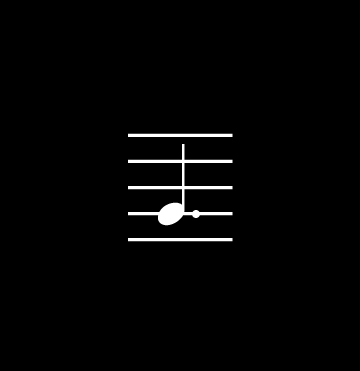
A dotted quarter note
A little bit of math gets involved here, but a dot essentially extends a note’s duration by half of its value. For example, a dotted quarter note is equivalent to a quarter note plus an eighth note, and a dotted half note is equivalent to a half note plus a quarter note.
Let’s hear how some commonly-used dotted notes sound in practice:
Sheet music
MIDI (piano roll)
What is tempo?
Last but not least, one important element of rhythm that we haven’t addressed yet is tempo, or the overall speed. In a DAW, we define the tempo by setting a BPM, an acronym that stands for “beats per minute.” Most projects are set to 120 BPM by default.

Here’s what a simple drum groove played at 120 BPM sounds like:
The speed at which a rhythm is played can totally transform its character. For example, here’s the same exact groove played at 90 BPM:
And here it is one more time, played at double the speed, 180 BPM:
Stylistic factors can contribute to how fast or slow you want to set your tempo. For example, if you’re creating an energy-packed drum and bass track, a tempo somewhere between 160 – 180 BPM might be a good starting point. On the other hand, if you’re looking to create a gentle waltz piece, you might set your tempo closer to 90 BPM.
In sheet music, tempi (the plural for tempo) are often a little more approximate. Though sometimes a specific BPM is notated, more often than not you’ll just see one of the following phrases at the top of the sheet that indicates the rough speed at which the piece is intended to be performed:
- Slow tempi: largo, grave, adaigo, etc.
- Medium tempi: moderato, andante, andantino, etc.
- Fast tempi: vivace, allegro, presto, etc.
Putting it all together
Let’s wrap things up by putting together everything we’ve learned. In the following rhythm, we combine regular notes, rests, and dotted values under a time signature of 4/4 and a tempo of 120 BPM.
Sheet music
MID (piano roll)
This is, without a doubt, a lot to take in (we’re speeding through what traditional music courses might spend days or weeks on). Definitely take the above example one beat at a time, and refer to the different sections of this article to understand why each part in the passage is expressed in the way that it is.
What is rhythm in music: Wrapping up
Once you feel pretty good, give yourself a pat on the back! While this is just an introduction, we’ve come quite far from when we posed our initial question, “What is rhythm in music?” Not only should you now be able to define rhythm and its core elements, but you should now also be well equipped to begin reading and creating rhythms.
That said, even if you’re not 100% confident, know that applying these concepts in the DAW firsthand as you make music will also be super helpful in reinforcing the material—as they say, you can’t learn how to ride a bike by just reading about it. In a separate post, we’ll specifically focus on using these abstract concepts to compose a drum groove in the DAW.
Explore royalty-free melodies, chord progressions, and grooves by key, BPM, genre, and more:
June 7, 2024

.svg)
.svg)

